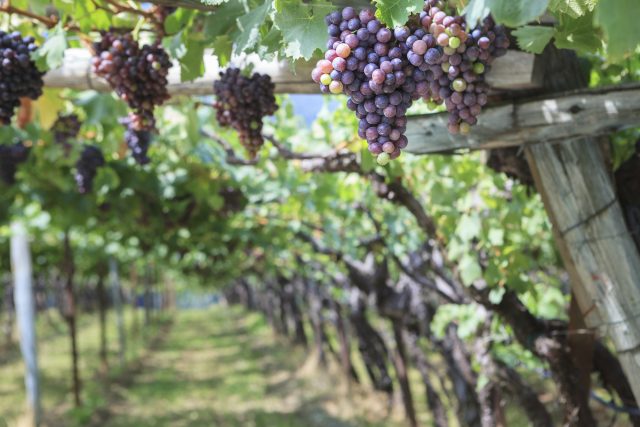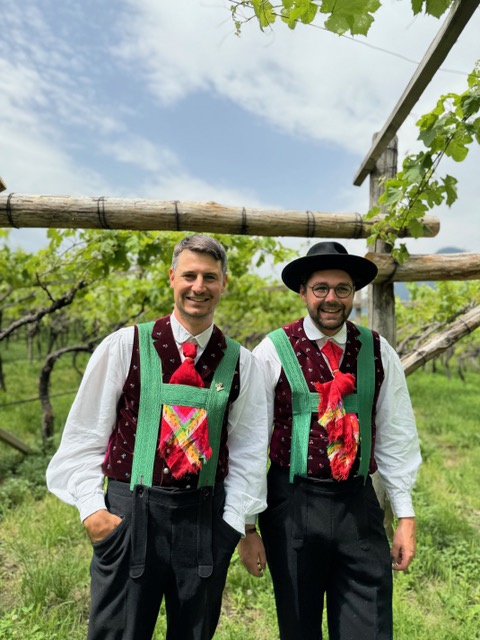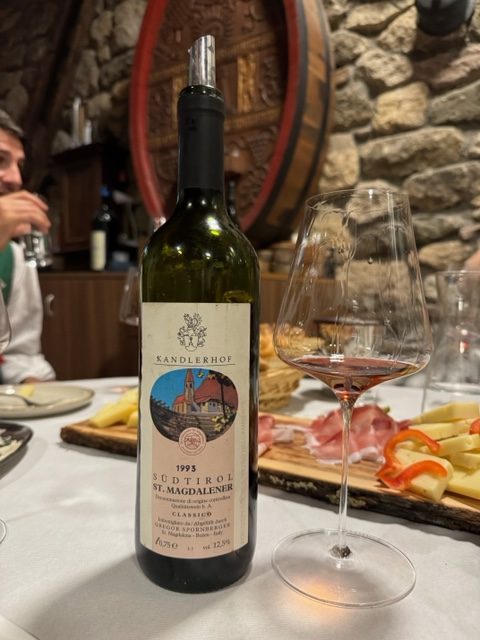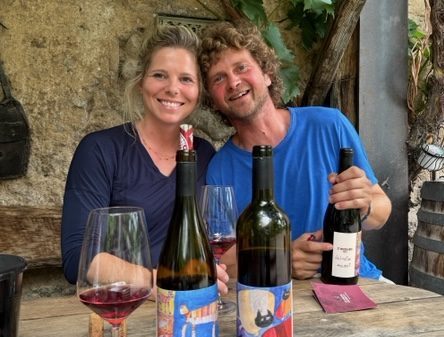This website uses cookies so that we can provide you with the best user experience possible. Cookie information is stored in your browser and performs functions such as recognising you when you return to our website and helping our team to understand which sections of the website you find most interesting and useful.
Vernatsch: Alto Adige’s contemporary red
Vernatsch, also known as Schiava, is far from the trendiest Northern Italian grape variety, but perhaps it should be. Filippo Bartolotta discovered more during a recent visit to Alto Adige.

As the wine market is asking for more bubbles, white wines and lighter reds, Alto Adige is holding its position as one of Italy’s most reliable sources for the first two categories while the decreasing acreage of the indigenous, light and transparent Vernatsch vines could lead to a double loss: regional identity and market opportunity.
The wines produced with Vernatsch are bright vibrant, crunchy and transparent reds packed with strawberries, mountain flowers, sweet roots, balsamic notes all released with a smooth and velvet touch and naturally low in alcohol.
Most Vernatsch is Pergola-trained, which means the grapes are protected from sunburn and global warming, but also that harvest must take place by hand as mechanisation is a no-go with this training system.
Vernatsch seems to be a dream variety for many winemakers, but it is becoming more of a conundrum for producers in Alto Adige as the grapes of this wonderful variety are priced at €3 per kg while Pinot Noir, Chardonnay or Sauvignong Blanc are two or three times more. As a result, last year another 100 hectares were uprooted, dropping the total surface down to only a little over 450ha. Vernatsch used to be the most-cultivated variety in Alto Adige, not too long ago accounting for almost four times today’s area under vine. As a matter of fact, Alto Adige used to be a predominantly red wine producer, while today is two-thirds white and one-third red.
So with this in mind, I went back to Alto Adige to learn more about one of the oldest and most successful native varieties in the region celebrated each year by a competition, the Vernatsch Cup, organised by the owner of the immaculate Vigilius Mountain Resort (where the event has been hosted since 2004), Ulrich Ladurner, Günther Hölzl of Pur Südtirol, and journalist Othmar Kiem.
Vernatsch in a nutshell
Given that 98% of the wines produced in Alto Adige are done so under DOC certification, Vernatsch is almost entirely produced as a DOC wine.
There are four sub-appellations for Vernatsch, and in each the variety has to make up at least 85% of the final blend. Lagrein is often the other component, giving the wines a darker colour and more astringent tannins.
- Alto Adige Schiava (Südtirol/Südtiroler Vernatsch)
This is a catchall appellation, and, as a result, more difficult to highlight specifics, although those from Nalles and Appiano seem to offer a more-structured body.
- Caldaro or Lago di Caldaro (Kalterersee/Kalterer)
These wines tend to be very fruity, with soft tannins.
- Meranese or Meranese di Collina (Meraner/Meraner Hügel)
The wines of this appellation show a darker colour, higher acidity, and crunchier fruit.
- Santa Maddalena (St. Magdalener)
The Vernatsch of the hills of Santa Maddalena release some clean red fruit, energy, depth and spices.
This latter appellation is the one I focused during a the exploration, meeting with four winemakers in what happened to become a walking wine tour. Santa Maddalena is a hill just a few steps away from the city of Bolzano and most wineries are next to each other so there is no need to drive, but rather hike the very steep hill and knock at the cellar doors.
The largest part of Santa Maddalena vineyards are split among many vignerons who own very small plots and bring their grapes to Cantina di Bolzano, which is the key player in the area. One of the most modern cooperatives in Italy, each year Cantina di Bolzano releases a St. Magadaler Classic in inox and two selections, the St. Magdalener Moar and a St. Magdalener Huck am Bach, both with a little presence of Lagrein and some large oak aging.
Community support
I started my hike from the city early to get all the way up to Cima del Monte Tondo at around 1000 metres above sea level, and down again. Alto Adige is basically all mountain, and I think it is only right to pay a visit to this region celebrating outdoor life. As I headed down towards my first appointment at at Kandlerhof (300 masl) with Hannes Spornberger, he greets me together alongside fellow winemaker Lukas Mumelter from Griesbauerhof, both of them dressed in local, traditional clothes as they were just getting back from Sunday mass for an important celebration.

Alto Adige is without any doubt one of the most modern, high tech wine regions in Europe, and yet it is also one of the most authentic and traditional ones. It is not uncommon to come across to some of the most cutting-edge winery buildings, as well as some 300-year-old farms (called ‘maso’) where families live and work together keeping the heritage alive.
The wine community in Santa Maddalena is very tight. The new generation is made of young winemakers who spent their childhoods together as friends and neighbours. So during my first visit with Spornberger, Mumelter was with us, and as we moved to the second winery we met with Stephan and Katerina Martini ,who joined us to go to the third winery to meet with Martin Ramoser at Fliederhof. Finally we all walked to Griesbauerhof to wrap up the Santa Maddalena walking wine tour.
This group of winemakers is close. They are not afraid to share best practices and they all sincerely love and enjoy their Vernatsch a lot. They explain to me the importance of the fluvial sandy/lime and pebbly soil that, together with the pink porphyry and calcareous rocks ,create a unique condition of hyper mineral soils which drain easily, leading to bright and vibrant character expressions of Vernatsch.
90% of the vineyards are trained with very old Pergola systems, which are all under an irrigation system which was the first ever built in Europe in 1929.
“They built it so perfectly with a tiny inclination so that we can activate it without any need for pumps or energy. Even today when we have to do some repairs ,we do not seem to be able to match the original level of precision,” said Stephan Martini.
Wines and wineries
Kandlerhof

Born in 1278, in the hands of the Spornberger family since 1793, this 2ha winery is located right at the foot of the Ritten mountains, northeast of Bolzano, which one can walk in 20 minutes from the centre of town. Hannes Spornberger is the new generation taking over from his father Martin and adding more reactivity to the wines. While tasting in the small cellar underneath the living room of the house, we opened a 1993 St. Magdalener Classic, which was gobsmackingly-young and brilliant, having the same aromas of a younger expression, but with more depth, sweetness and smooth volume. Yes, Vernatsch from great sites can age well!
- Kandlerhof, St. Magdalener Classic 2023: This is one of the most vibrant and refreshing Vernatsch you can come across. Delicious field strawberries, red currants together with some more complex aromatic of graphite, quinine, rhubarb and hibiscus. Light and refreshing this is a classic, “false simple” red one could drink forever.
Fliederhof
Only a few steps away from Kandelhof, right under the bell tower of St. Magdalena Church, is the small family-run winery of Fliederhof. 3ha only, and biodynamic since 2020. Although only a stone’s throw from the sand/porphyry-based soil on the terrace top of the hill, here the soil is rockier and, as a result, Ramoser’s wines show more structure and deeper colour.
- Santa Maddalena Classico Alto Adige, Gaia 2020: This St. Magdalena Classico is maybe less classic and more contemporary but it is utterly delicious. Whole cluster fermentation with gentle manual pressing and some exhausted barrique aging. The result is the most saline Vernatsch I’ve ever tasted. It’s packed with roses, passion fruit, liquorice and bee wax. Dangerous drinkability.
Weingut Sonnleighten

From the top of St. Magdalena terrace, Stephan Martini and myself hike downhill towards his wife’s winery, Weingut Sonnleighten. He has a happy-go-lucky attitude and as we walk across several vineyards he explains how tough it is to work all by hand as no machinery can actually climb here, so the yields are only around 50hl/ha. As we approach the winery we are surrounded by six or 7 kids roaming around the courtyard surrounded by immaculate pergola vineyards.
- St. Magalena Juzer 2023: This Schiava, once again shows the combination of sweetness, smoothness, depth and crunchiness. The aromas of goji berries, mountain strawberries, mint, blue flowers, cola and the juicier finish one can immagine.
Griesbaurhof
At the bottom of the valley is Griesbaurhof. We carry on our walk past the vines, and past the grammar school where all the young winemakers I am walking with spent their childhood. Maso Griesbauer has belonged to the Mumelter family since 1875.
- St. Magalener Isarcus Classico 2022: This wine is the result of old vines, some of which are older than 100 years. 25% whole cluster fermentation and with a little percentage of late harvest grapes to add up some pulpier fruit to the blend. This is an amazing umami driven Vernatsch with a combination of soy sauce, lavender flowers, orange zest, passion fruit, and sweet roots with a very savoury finish.
Final thoughts
Alto Adige is home to some refined Michelin-starred restaurants as well as some simple and cosy ‘baite’ (mountain hut restaurants) with some seriously delicious food, and Vernatsch is one of the most versatile food partners I have ever encountered, whether it is with fish, meat or pizza. So when in doubt as to what wine to pick for dinner, Vernatsch is your safe choice. Its light body and low-alcohol make it perfect to serve a little chilled, turning it into a beautiful, intuitive, and yet complex, almost rosè-like wine.
We can only hope Alto Adige is not going to lose another 100ha next year, but rather plant some great Pergola-trained Vernatsch.

